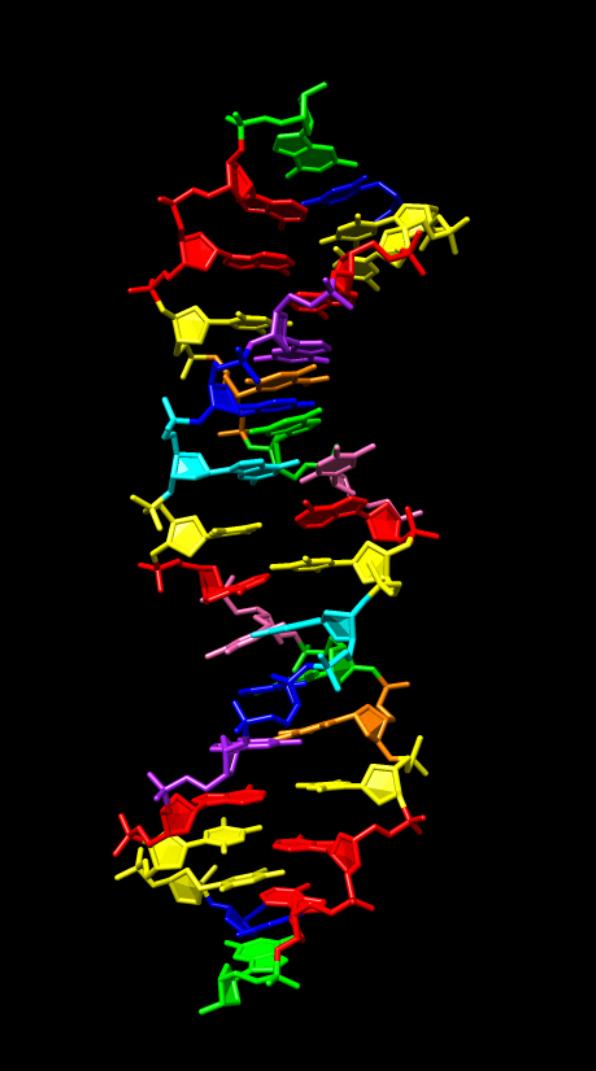Doubling the building blocks for DNA
March 5, 2019
Doubling the building blocks for DNA
At a Glance
- Scientists created novel DNA structures from four synthetic and four natural building blocks.
- The discovery could pave the way to developing novel medical diagnostic devices, treatments, and information storage methods.

DNA is a molecule made up of four chemical bases: adenine (A), cytosine (C), guanine (G), and thymine (T). For the two strands of DNA to zip together, A pairs with T, and C pairs with G. Each pair comprises a rung in the spiral DNA ladder. The order of these building blocks in a DNA molecule determines the genetic sequence. These sequences make genes—the instructions for making specific proteins—and other genetic elements.
Scientists have been working to create new chemical bases that would add to the four natural building blocks to create novel DNA sequences. Past studies have used an artificial pair of building blocks with the two natural base pairs. With six building blocks rather than four, many more combinations were possible. Researchers have even inserted synthetic DNA into living cells and directed the cells to make novel proteins.
A team led by Dr. Steven A. Benner of the Foundation for Applied Molecular Evolution set out to design and synthesize four chemical bases and combine them with the four natural bases to construct novel DNA strands. The research was supported by NIH’s National Institute of General Medical Sciences (NIGMS), NASA, and others. Results appeared in Science on February 22, 2019.
First, the team designed two pairs of building blocks that would have the same size and shape as the natural A:T and C:G pairs. The letters P, B, Z, and S were used to denote the synthetic building blocks. Then they designed structures containing both natural and synthetic building blocks. The researchers named their synthetic strands of eight building blocks “hachimoji” DNA. In Japanese, hachi means eight, and moji means letter.
The researchers analyzed the crystal structures of the DNA. Although slightly different than natural DNA, the synthetic DNA retained the overall twists and bends of the DNA spirals. Just as with natural DNA, different letter sequences didn’t change the overall shape of the hachimoji DNA.
Next, the team tested whether their novel DNA could transmit encoded genetic information. They tested the synthetic DNA with different enzymes. They showed that, given the right enzyme, hachimoji DNA strands could be translated into hachimoji RNA. RNA is the messenger that carries instructions between DNA and the cellular machinery to make proteins.
With hachimoji DNA, scientists might be able to fabricate new classes of diagnostic and potentially therapeutic molecules. The novel DNA also has potential for development into information storage platforms.
In addition, this research gives insights into other genetic systems that could serve as the foundation for life. “By carefully analyzing the roles of shape, size, and structure in hachimoji DNA, this work expands our understanding of the types of molecules that might store information in extraterrestrial life on alien worlds,” Benner explains.
—by Geri Piazza
Related Links
- Expanding the Genetic Alphabet
- Containing Genetically Modified Bacteria
- Scientists Recode Organism’s Genome
- The New Genetics
- Genetic Code
- What Is DNA?
References
Hachimoji DNA and RNA: A genetic system with eight building blocks. Hoshika S, Leal NA, Kim MJ, Kim MS, Karalkar NB, Kim HJ, Bates AM, Watkins NE Jr, SantaLucia HA, Meyer AJ, DasGupta S, Piccirilli JA, Ellington AD, SantaLucia J Jr, Georgiadis MM, Benner SA. Science. 2019 Feb 22;363(6429):884-887. doi: 10.1126/science.aat0971.
Funding
NIH’s National Institute of General Medical Sciences (NIGMS); National Aeronautics and Space Administration; National Science Foundation; U.S. Department of Energy; and Templeton World Charity Foundation.


